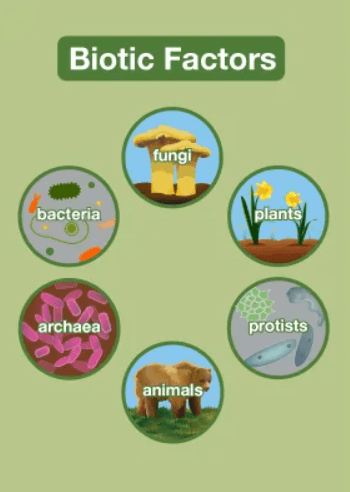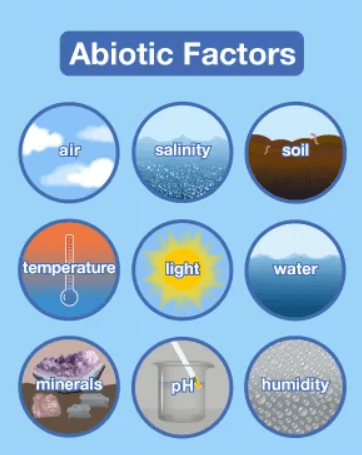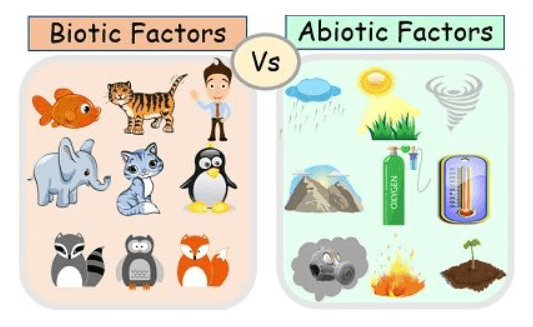An ecosystem is a dynamic and interconnected system comprising both living and non-living components. The abiotic factors, including elements like soil, water, sunlight, temperature, and climate, shape the physical environment. While the biotic factors encompass a wide array of living organisms, from plants and animals to fungi and microorganisms.

Producers, such as plants and certain algae, harness energy through photosynthesis, initiating the flow of energy. Consumers, forming intricate food chains and food webs. An ecosystem consists of two different components: Abiotic and Biotic components. These biotic and abiotic components are one of the major topics of the class 10th biology section.
What are Abiotic and Biotic Factors
Biotic: Biotic factors refer to the living components within an ecosystem. This includes organisms of Kingdom Plantae, Kingdom Animalia, Kingdom fungi, bacteria, and other microorganisms. Biotic factors interact with each other, competing for resources, preying on each other, or engaging in symbiotic relationships, and completely they contribute to the overall dynamic of the ecosystem.

Abiotic: Abiotic factors, on the other hand, encompass all the non-living elements in an ecosystem. These include physical and chemical factors such as temperature, humidity, sunlight, soil composition, water availability, air quality, and geological features. Abiotic factors are essential because they provide the environmental conditions that affect the distribution, behavior, and survival of biotic organisms within the ecosystem.

Difference Between Abiotic and Biotic Factors
We have mentioned some differences between abiotic and biotic factors that will highlight the fundamental distinctions between abiotic and biotic factors in an ecosystem.

| Difference Between Abiotic and Abiotic Factors | ||
| Aspects | Abiotic factors | Biotic factors |
| Nature | Abiotic factors include all the non-living components. | Biotic factors include all living organisms. |
| Origin | Geological, chemical, and physical processes. | Biological processes. |
| Examples | Examples of abiotic factors include; temperature, sunlight, water, minerals, etc. | Examples of biotic factors include; animals, plants, fungi, microorganisms, etc. |
| Interactions | Abiotic factors affect biotic factors through environmental conditions (e.g., temperature affecting animal activity). | Biotic factors interact with each other through predation, competition, symbiosis, etc. |
| Response to Change | Abiotic factors are less adaptable and responsive to change compared to biotic. | Biotic factors can adapt, evolve, and respond to environmental changes over generations |
| Energy Source | Abiotic factors provide energy to ecosystems (e.g., sunlight). | Biotic factors consume energy through metabolic processes |
| Reproduction | Abiotic factors do not reproduce or have a life cycle. | Biotic factors reproduce, grow, and have life cycles. |
| Ecosystem Function | They provide a physical framework and basic resources for the ecosystem. | Biotic factors define ecological interactions and diversity within an ecosystem. |
Advantages of Biotic and Abiotic Factors
Biotic and Abiotic factors both play a crucial role in ecosystems, each with its own set of advantages. The advantages of biotic and abiotic factors are intertwined, as they work together to create and maintain complex ecosystems. Biotic factors contribute to biological diversity and ecosystem functions, while abiotic factors provide the physical and environmental context that supports life.
Advantages of Abiotic Factors
- Climate Regulation: Abiotic factors like temperature, rainfall, and sunlight influence climate patterns, which in turn affect the types of species that can thrive in an area.
- Habit Formation: Abiotic factors can shape physical habitats, such as the formation of rivers, lakes, mountains, and caves, providing diverse environments for organisms to inhabit.
- Soil Formation: Abiotic factors like weathering and erosion contribute to soil formation, creating a substrate for plant growth and nutrient cycling.
- Geological Processes: Abiotic factors, including tectonic movements and volcanic activity, can shape landscapes and create unique geological features that influence ecosystems.
- Water Availability: Abiotic factors determine the availability of water, a critical resource for all life forms.
Advantages of Biotic factors
- Biodiversity: Biotic factors, including plants, animals, and microorganisms, contribute to the rich diversity of life in an ecosystem, enhancing its resilience and adaptability.
- Nutrient cycling: Organisms participate in nutrient cycling by decomposing organic matter, and recycling essential elements like carbon and nitrogen, which benefits the overall health of the ecosystem.
- Pollination and seed dispersal: Biotic factors like pollinators (e.g., bees, butterflies) and seed dispersal (e.g., birds, mammals) facilitate plant reproduction and seed distribution, promoting plant growth.
- Predator-Prey Relationships: Biotic interactions such as predation help control populations of organisms, preventing overpopulation and maintaining ecological balance.


 50 Vegetables Name for Kids in English a...
50 Vegetables Name for Kids in English a...
 Food Chain: Definition, Types, Examples,...
Food Chain: Definition, Types, Examples,...
 Human Respiratory System: Definition, Di...
Human Respiratory System: Definition, Di...













